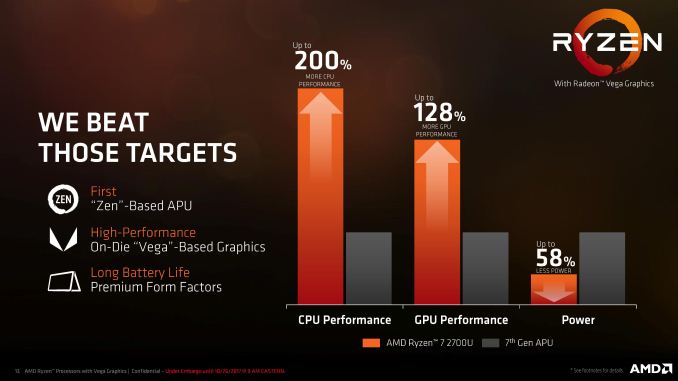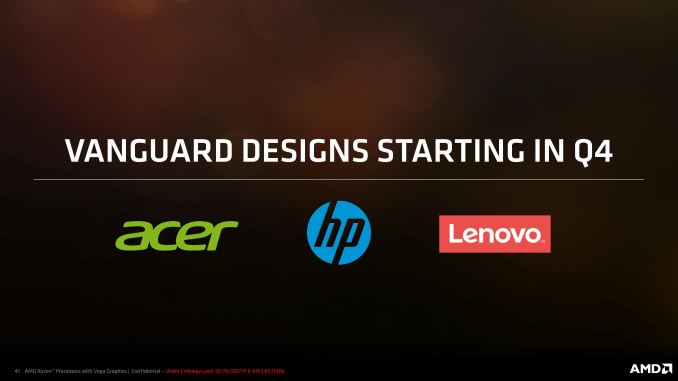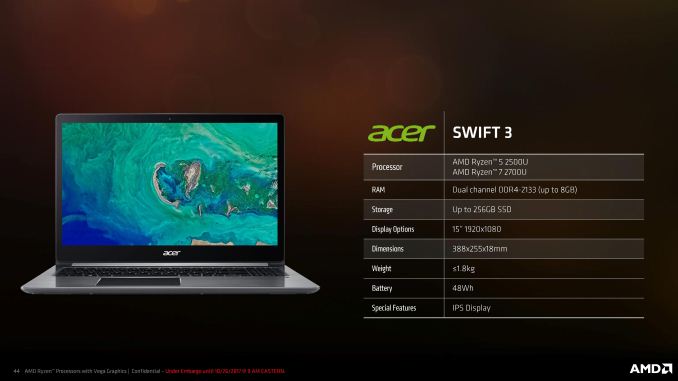Ryzen Mobile is Launched: AMD APUs for Laptops, with Vega and Updated Zen
by Ian Cutress on October 26, 2017 9:00 AM ESTAMD Ryzen Mobile: Zen 1.5
During our pre-briefings on Ryzen Mobile, it was asked why the two new APUs were using the 2000-series numbers, and not the 1000-series numbers like the desktop parts. It was assumed by the press that the first generation of Ryzen would all be under the 1000-series, including the mobile parts. The response given by Kevin Lensing, AMD’s Corporate VP of the Client Business Unit, was that so many of the design ideas that AMD wanted to put into the original desktop Ryzen (but couldn’t due to time) eventually ended up in Ryzen Mobile, such as the updated precision boost. While there are no architectural changes to Zen to warrant a next-generation microarchitecture name, this version of Ryzen’s periphery (i.e. the power) was more in-line with an original vision and had to be presented as such. This is why we have Ryzen 7 2700U, rather than a Ryzen 7 1700U. He would not comment if the true next generation Ryzen desktop naming would still be the 2000 series, or if we would go straight to 3000. Who knows, it might alternate.
The state of Zen aside, AMD’s return to high-performance computing with the Zen core was naturally going to trickle down into the notebook space. The question everyone asked is if such a high-power, high-performance core was going to make it in such a small power envelope: especially when you add some big graphics core next to it. In our desktop Ryzen reviews, we saw per-core power go as low as 8W per core, and AMD’s Vega was power hungry – promising to put four cores and some graphics into a single piece of silicon with a 15W TDP sounded harder than an uphill task, almost Sisyphean in nature. AMD has approached that by taking new methods to its power topology, how it manages that power, and found a combination of frequencies and performance that tally up to that 15W mark. They have also worked closely with the first three OEMs that are launching systems today to ensure a good user experience.
For performance, Ryzen Mobile has four cores with multithreading, with frequencies up to 3.8 GHz. This should give the mobile processor enough grunt under the hood in the 15W envelope to cater for a significant number of demanding workloads. GPU performance is also up, with AMD also hoping to push the hardware into a number of gaming-focused devices with FreeSync panels in the new few months. AMD is also touting significant power reductions during high-load tasks, leading to a 270% performance per watt improvement. More impressive is the steps taken towards how the processor manages power between cores and the GPU: a very complex implementation hopefully leading to a better power profile and 15-30% better battery life than previous generations for common use cases.
For the launch, AMD has partnered with HP, Acer and Lenovo for systems to go on shelves. As I am currently writing this, only HP provided any information about their upcoming systems and we’re likely to scramble when the other press releases come out. None of the three designs are ultimate eye-catching flagships, but rather approaching that middle-range $600-$1000 notebook territory with 13.3 inch 4K displays, up to 1TB SSDs, 48-55Wh batteries, and a device or two that can flip into a tablet. When we played briefly with the Acer unit in our pre-briefing, there was no lag – a user would be hard-pressed to immediately see a difference to a comparative Intel system.
Ultimately AMD has several very hard tasks ahead of it for Ryzen Mobile. Firstly it has to re-educate the sales teams at brick and mortar stores like Best Buy, who have only ever seen AMD has the low-cost budget option. If they still think the same way when Ryzen Mobile comes to town, they won’t be recommending them.
Second, they have to educate the public – after years of miserable user experiences leading to negative feedback loops, AMD has to convince these users that it is worth looking at AMD-powered devices again and there isn’t some sort of catch. Part of this solution will be in how well AMD integrates itself into the OEM sampling strategy for reviews, and if any reviewers are going to get devices this time around.
Third, AMD is several steps behind Intel in its marketing message: while Intel is trying to explain new ways to use the hardware (such as the failed ‘PC Does Whaaat?’ campaign almost a couple of years ago to the day), AMD is on the ‘I’m here too, and I’m just as good’ message. Back when we analyzed the Carrizo user experience, one thing we pointed out is that with most Intel flagships, most users do not even know what processor is inside – to these customers, saying ‘I’m just as good’ might give the impression ‘well what was wrong before?’. It might take AMD a round of flagships and XPS 13 or Zenbook Infinity-type designs to get the attention on their side of the discussion.
We have reached out to all three of the main OEMs who have Ryzen Mobile systems being announced today, but only one responded in time. This doesn’t bode well for any sampling, but we’re sitting here with a megaphone until we get one. Stay Tuned.
As part of this launch, AMD also discussed its progress towards its 25x20 goal, and AMD actually provided some data on how they are calculating this. We analyzed what AMD still has to do in a separate article, and you can read about it here:
http://www.anandtech.com/show/11965/amds-progress-on-its-25x20-goal-the-task-ahead














140 Comments
View All Comments
kulareddy - Thursday, October 26, 2017 - link
But GPU architecture is Vega.MajGenRelativity - Thursday, October 26, 2017 - link
And?artk2219 - Thursday, October 26, 2017 - link
Newer is not always better, just look at the P4 and Bulldozer for examples of that (Not that Vega is bad, far from it). But honestly you're comparing a 15w part with something that's like 110w. Yes efficiency and node shrinks help immensely, but there's still something to be said for higher power limits on older hardware. Now it does have support for newer modes and newer instruction sets so in time it could get better, but I dont think it will ever really run away from the performance level of the xbox one or ps4 in any meaningful way. All that being said, you'll have all of that performance in a thin and light that you can travel with.https://www.anandtech.com/show/7528/the-xbox-one-m...
MajGenRelativity - Thursday, October 26, 2017 - link
Exactly. Vega has a lot of promise, but its performance remains mostly untapped for now.guidryp - Thursday, October 26, 2017 - link
Vega is really no faster clock for clock, than previous generation.Also, this APU doesn't have nearly the bandwidth that the PS4 has, nor the EDRAM cache that the XB1 has, so GPU performance will not match up to those.
Samus - Thursday, October 26, 2017 - link
That's only true when comparing legacy software under both platforms. There are pretty substantial IPC gains, but they require optimization. It's the same reason MMX, SSE, 3DNOW, etc, all had pretty substantial benefits to programs that utilized them, and those were simply extensions of current architecture. Zen is an entirely new x86-compatible model.StevoLincolnite - Friday, October 27, 2017 - link
Vega is much faster than previous generations especially when compared to GCN1.0.And especially in bandwidth constrained scenario where AMD's Delta Colour Compression and improved culling comes into play.
DDR4 2400Mhz is one such bandwidth constrained scenario.
AMD should have thrown DDR4 3200Mhz or more support at the problem.
Alexvrb - Saturday, October 28, 2017 - link
Frequency by itself doesn't tell you the whole picture. Ryzen on the desktop had good bandwidth at a given frequency, so I think Ryzen Mobile will do fine against Kaby Lake Refresh. It doesn't have to worry about cross-CCX latency, so there's reduced need for faster clocked RAM.Also, it's not as easy as "turn this knob and get a perfect IMC that does all the things for zero power". They did the best they could. Not to mention you won't see support for high speed RAM in most laptops running integrated graphics. So for Ryzen Mobile it's actually better to extract as much bandwidth as they can from more common RAM.
Gigaplex - Thursday, October 26, 2017 - link
You're not taking into account the memory architecture. The consoles use faster memory, and these APUs are generally memory bandwidth limited.StevoLincolnite - Friday, October 27, 2017 - link
Consoles also don't have delta colour compression and the tiled rasterizer.So whilst it wont have the same bandwidth as say... The PS4 in theoretical terms. It would likely beat the Xbox One S.